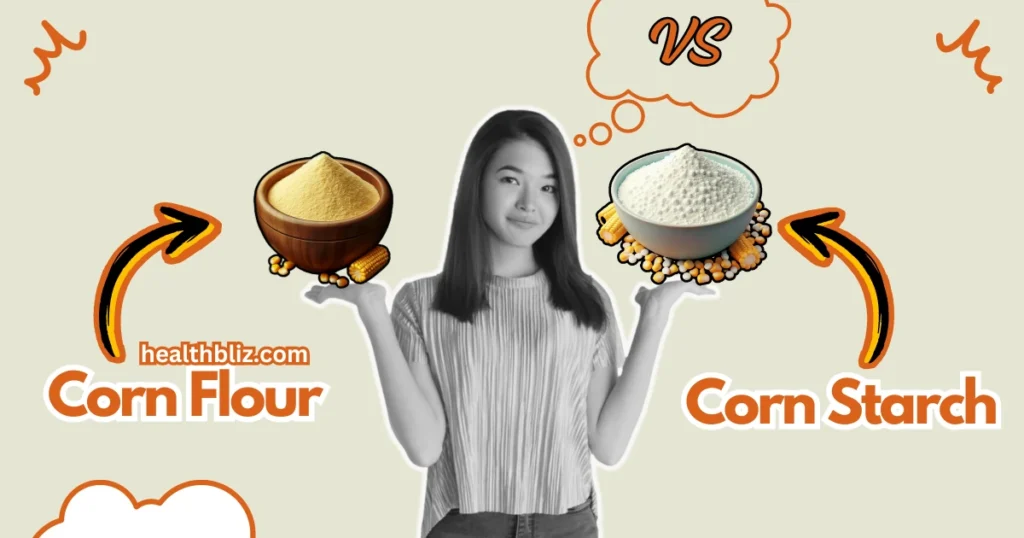
Corn flour and cornstarch are derived from corn, but they vary in terms of their nutrient compositions, flavors, and applications. In the United States, corn flour refers to a finely ground powder that is obtained from whole corn kernels. On the other hand, cornstarch is also a fine powder, but it is exclusively made from the starchy component of corn.
Due to their unique nutritional profiles and distinct manufacturing processes, these two ingredients find different uses in cooking. Furthermore, it is worth noting that the names for cornstarch and corn flour may differ in various regions around the world.
This comprehensive article provides you with all the essential information regarding the disparities between corn flour and cornstarch.
Processing of corn flour vs cornstarch
Corn flour is produced by grinding whole corn kernels into a fine powder, retaining protein, fiber, and starch, as well as the vitamins and minerals present in whole corn. It usually has a yellow hue.
In contrast, cornstarch is a more refined product, created by eliminating the protein and fiber from the corn kernel, resulting in a white powder.
Nutritional composition
Below is a comparison of the nutritional composition between 1/4 cup (29 grams) of cornstarch and corn flour (1, 2).
| Nutrient | Corn Flour | Cornstarch |
|---|---|---|
| Calories | 110 | 120 |
| Protein | 3 grams | 0 grams |
| Fat | 1.5 grams | 0 grams |
| Carbohydrates | 22 grams | 28 grams |
| Fiber | 2 grams | 0 grams |
Different flavors
Corn flour has a distinct corn flavor that results from grinding the entire corn kernel into a fine powder. This corn flavor can add a subtle sweetness and earthiness to dishes, making it a popular choice for recipes that emphasize the taste of corn. It’s commonly used in traditional dishes like cornbread, tortillas, and muffins, where the corn flavor is a key component.
Cornstarch, on the other hand, has virtually no flavor. Because it is made entirely of the starchy part of the corn kernel and does not contain the bran or germ, it lacks the corn flavor found in corn flour. Cornstarch’s neutral flavor makes it versatile and suitable for use in a variety of recipes where the corn flavor does not overpower other ingredients.
Different colors and textures
When comparing corn flour to cornstarch, there are noticeable differences in texture and color. Corn flour, with a finely ground consistency similar to traditional wheat flour, has a slightly coarser texture due to its origin from whole corn kernels. This texture creates a pleasing crumb structure in baked goods like bread, muffins, and pancakes.
Cornstarch, on the other hand, has an ultra-fine texture similar to powdered sugar because it is extracted entirely from the starchy endosperm of the corn kernel. Cornstarch’s fine texture allows it to form smooth, clear gels when mixed with liquids, making it an excellent thickener for sauces, gravies, and pie fillings. Furthermore, while corn flour has a pale yellow hue, cornstarch is completely white and devoid of flavor or aroma. This color distinction makes cornstarch ideal for thickening clear sauces where the dish’s natural color is important.
Interchangeable
Cornstarch and corn flour have different nutritional compositions, which means they cannot be used interchangeably in recipes.
Corn flour is versatile and can be used to make various baked goods such as breads, pancakes, biscuits, waffles, and pastries. It can also be used as a substitute for wheat flour, adding a distinct corn taste and a yellow color to the final product. However, it’s important to note that corn flour lacks gluten, the main protein found in wheat flour that gives elasticity and strength to breads and baked goods. As a result, using corn flour may lead to a denser and crumblier texture in the finished product.
On the other hand, cornstarch is primarily used as a thickening agent in soups, stews, sauces, and gravies. To prevent lumps, it should be mixed with a cold liquid before adding it to a hot dish. Unlike corn flour, cornstarch is mainly composed of starch and does not contain protein or fat. This means that it cannot be used in the same way as corn flour when it comes to baking.
Additionally, cornstarch is commonly used in fried or breaded foods to achieve a crispy finish. It is also often added to confectioners’s sugar to prevent clumping.
How to make corn flour
Making corn flour at home is easy. Start with dried corn kernels, clean them, and then grind them into a fine powder using a grain mill or blender. Optionally, sift the flour for a smoother texture. Store the homemade corn flour in an airtight container and use it in your favorite recipes, like cornbread and pancakes, for fresh flavor.
How to make cornstarch
Making cornstarch at home involves soaking dried corn kernels, grinding them into a paste, straining to separate the starch from the liquid, allowing the starch to settle, draining off the liquid, drying the starch, and storing it for future use.
Frequently Asked Questions
Q1: Can I use corn flour instead of cornstarch?
A1: Yes, corn flour can be used in place of cornstarch, but keep in mind that the textures are different and the results may differ slightly in the recipe. Adjustments may be required.
Q2: Is corn flour good for health?
A2: Yes, corn flour can be a healthy choice because it is naturally gluten-free and contains important nutrients like fiber, vitamins, and minerals. However, like any food, moderation is essential.
Q3: Which is healthier, cornstarch or corn flour?
A3: Corn flour is generally healthier than cornstarch.
The bottom line
Corn flour is a finely ground, dried yellow powder derived from corn, whereas cornstarch is a fine, white powder extracted from the starchy portion of a corn kernel. The names of these two substances may vary depending on your geographical location. Corn flour can be utilized in a similar manner to other types of flour, while cornstarch is primarily employed as a thickening agent.
People also like to read:


